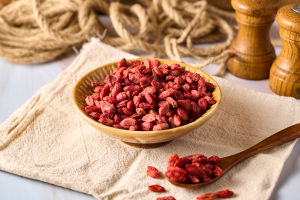
When we talk about superfoods, it's impossible not to mention goji berries. Scientifically known as Lycium chinense, goji berries belong to the Solanaceae family, the same as tomatoes and eggplants. This small but mighty plant grows into a deciduous shrub about 1.5 to 2 meters tall.
Its branches are thin, often bending at the tips, and are decorated with small thorns. We can easily recognize its leaves — they are oval-shaped, grow alternately or cluster together, and bring a simple beauty to the bush.
How Goji Berries Look and Grow
During summer and autumn, goji plants bloom with lovely light purple flowers, usually in small clusters of one or two. As the flowers fade, bright red, oval-shaped berries appear. These berries are juicy and vibrant, with kidney-shaped seeds hidden inside. We can find these berries thriving across many regions where the climate is temperate and slightly dry.
The Many Faces of Goji Plants
Interestingly, the goji plant is a real multitasker. It's not just the berries that are valuable. We often enjoy the tender young leaves, known as "goji tips," in various dishes. Meanwhile, the root bark, called "di gu pi" in traditional medicine, is prized for its cooling properties. Goji berries themselves, commonly referred to simply as "goji," have long been celebrated for their role in traditional remedies and nutritional tonics.
Goji's Close Cousins
Many of us might have heard of another variety, Lycium barbarum, or Ningxia goji. It's a close relative of Lycium chinense, and both types are widely used for their health benefits. Despite slight differences in size and taste, they are often seen as interchangeable, especially when used for making teas, soups, or health supplements.
Why Goji Berries Are So Loved
We can't ignore the growing popularity of goji berries around the world. They are packed with nutrients like vitamins, minerals, and antioxidants. People often include them in smoothies, oatmeal, or simply enjoy them as dried snacks. It's amazing how such a small fruit can add such a big nutritional boost to our daily routine.
Fun Facts About Goji
Here’s something cool — the English name "wolfberry" is actually a direct translation from the Chinese name. The story behind the "wolf" part is still a little mysterious, but it definitely adds a wild and adventurous flavor to the name! Plus, while goji berries look delicate, they are incredibly resilient, surviving in tough environments where many other plants might struggle.
Let's Embrace the Power of Goji!
So Lykkers, it's time for us to welcome goji berries into our lives! We can toss a handful into our morning oats, mix them into salads, or enjoy them straight as a tasty snack. Every small bite is packed with natural goodness, giving us a simple way to feel stronger and more energized. Let's keep discovering more amazing plants and create healthier, happier days together!
Goji Berry Benefits | How and Why I Eat Them
Video by Minus The Gym


